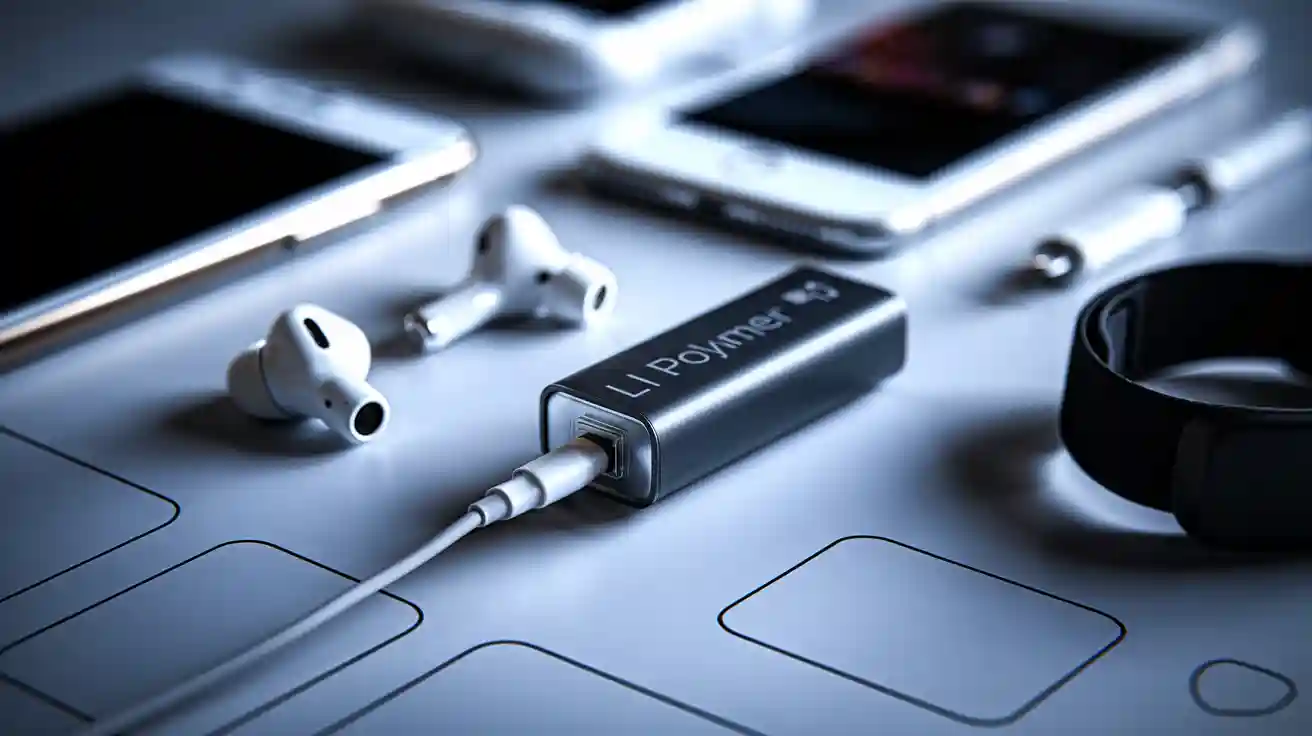
Battery li polymer 3.7v stands out as the top choice in portable electronics. This lithium battery type features stable voltage, high energy density, and advanced safety. Manufacturers rely on lipo battery technology to power devices in many industries. Common applications include wearable electronics, smart home devices, and portable medical monitors. Devices such as smartwatches, fitness bands, and health sensors benefit from the reliable performance and lightweight design of this lipo battery. The voltage stability and customizable form factor make battery li polymer 3.7v ideal for modern electronics.
- Wearable medical devices: smartwatches, fitness trackers, health sensors
- Smart home devices: video doorbells, motion sensors
- Portable medical monitors: insulin pumps, digital thermometers
Battery Li Polymer 3.7V Basics
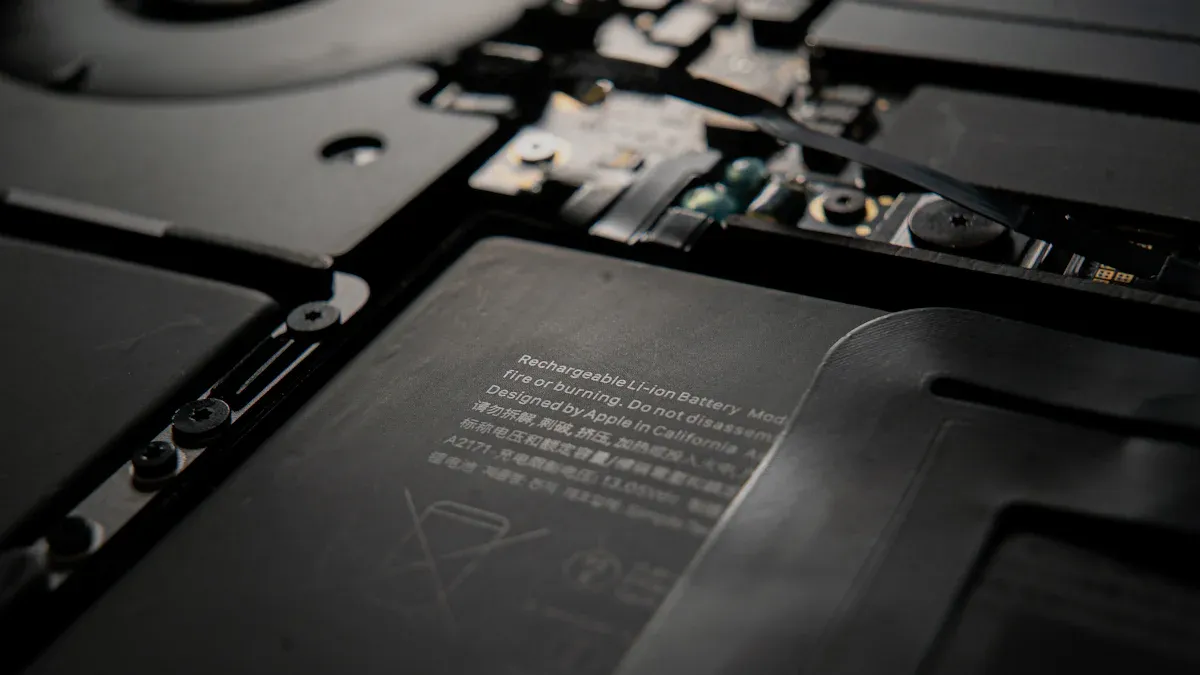
Structure and Chemistry
A battery li polymer 3.7v uses advanced materials and a unique structure. Each lipo battery contains a cathode, an anode, an electrolyte, a separator, and a protective circuit. The cathode often uses lithium-transition-metal-oxides like LiCoO2 or LiMn2O4. The anode is usually made from lithiated graphite. The polymer-based electrolyte replaces the liquid electrolyte found in many lithium-ion batteries. This change makes the lithium polymer battery lighter and more flexible. The separator, made from porous polymers, keeps the anode and cathode apart while allowing ions to move.
Note: The flexible aluminum pouch design of a lipo battery allows for many shapes and sizes, making it ideal for portable devices.
The internal structure of each cell often uses spirally wound layers. This design, along with the polymer electrolyte, gives the battery li polymer 3.7v its key characteristics: light weight, flexibility, and improved safety. Unlike traditional lithium-ion cells, the lithium polymer battery does not need a heavy metal case. However, it can be more sensitive to physical damage.
| Komponente | Material/Function |
|---|---|
| Kathode | Lithium-transition-metal-oxides |
| Anode | Lithiated graphite |
| Elektrolyt | Polymer-based (gel or solid) |
| Abscheider | Porous polymer membrane |
| Circuit | Protection and safety features |
Voltage and Charging
A lipo battery operates with a nominal voltage of 3.7V per cell. The full charge voltage reaches 4.2V, while the discharge cut-off voltage is about 3.0V. Most users avoid discharging below 3.3V to protect the lithium battery. Charging a lithium polymer battery uses a two-step process. First, the charger supplies constant current as the voltage rises. When the cell reaches 4.2V, the charger switches to constant voltage, and the current drops until charging stops.
- Always use a charger designed for lipo battery cells.
- Avoid overcharging above 4.2V or discharging below 3.0V.
- Regularly inspect the circuit and cell for swelling or leaks.
A lithium-ion battery and a lithium polymer battery both use lithium-ion cells, but the lipo battery stands out for its lighter weight and flexible design. The voltage characteristics of each cell are critical for safety and performance. Following proper charging protocols helps extend the life of the lithium battery and keeps the circuit safe. Many lithium-ion batteries include a protection circuit to prevent overcharging, over-discharging, and short circuits. These features make the battery li polymer 3.7v a reliable choice for modern lithium-ion systems.
Performance of LiPo Battery
Die Energiedichte
Energy density measures how much energy a battery can store in a given weight or volume. The lipo battery offers an energy density of about 150 Wh/kg. This value is higher than lead-acid and LTO batteries but lower than NMC, NCA, and new lithium-sulfur types. The lipo battery provides a balance between energy storage and safety, making it a strong choice for portable electronics.
| Batteriechemie | Nennspannung (V) | Energiedichte (Wh/kg) | Anmerkungen |
|---|---|---|---|
| 3.7V LiPo (Lithium Polymer) | 3.7 | ~150 | Moderate energy density, commonly used in consumer electronics |
| NMC (Nickel Manganese Cobalt) | ~3.6 | 220 – 300 | Higher energy density, widely used in automotive applications |
| NCA (Nickel Cobalt Aluminum) | ~3.6 | 250 – 300 | Very high energy density, often blended with NMC for balance of safety and capacity |
| LiFePO4 (LFP) | 3.2 | ~177 | Lower voltage, known for safety and long cycle life, lower energy density than NMC/NCA |
| Lithium-Sulfur | K.A. | >600 | Experimental, very high potential energy density but shorter lifespan |
| LTO (Lithium Titanate) | 2.4 – 2.8 | 60 – 70 | Low energy density, extremely long cycle life, used in heavy-duty applications |
| Blei-Säure | K.A. | ~30 – 50 | Much lower energy density, heavier and shorter lifespan |
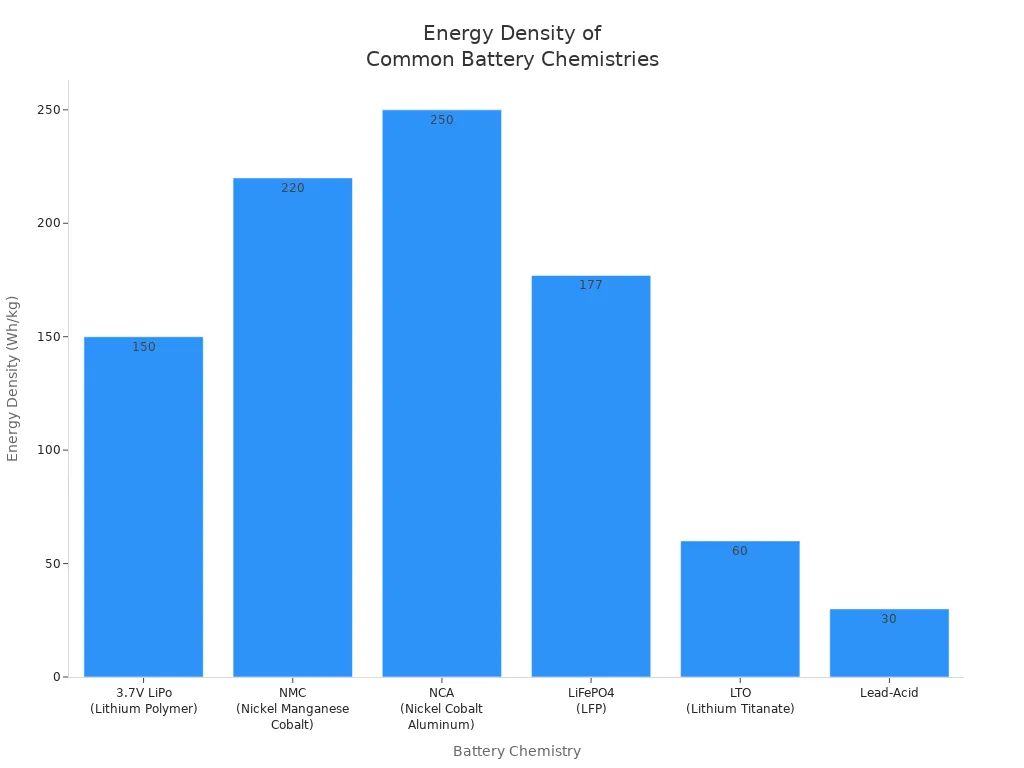
The lipo battery stands out because it can store more energy in a smaller and lighter package. This feature allows engineers to design thinner and lighter devices. The higher nominal voltage of 3.7V per cell means fewer cells are needed to reach the required voltage for most electronics. As a result, devices become more compact and portable.
- LiPo batteries have a higher energy density than many other rechargeable batteries of the same size and weight.
- Their volumetric energy density is about 500 Wh/L, and their mass energy density is around 200 Wh/kg.
- The higher voltage per cell reduces the number of cells needed, making devices smaller and lighter.
- Flexible shapes and sizes help engineers use space more efficiently inside devices.
- The combination of high energy density and flexible form factors improves the portability and features of modern electronics.
The energy storage capability of the lipo battery supports longer device run times and more powerful features. This balance of energy density and design flexibility makes the lipo battery a popular choice for portable electronics.
Zyklus Leben
Cycle life describes how many times a battery can be charged and discharged before its performance drops below a usable level. The lipo battery usually lasts between 300 and 1000 cycles, depending on care and usage. Under ideal conditions, a lithium battery of this type can reach about 500 full charge cycles, which equals about two to three years of use. However, real-world factors such as charging habits, temperature, and Entladungstiefe can shorten this lifespan.
| Akku-Typ | Typical Cycle Life Range |
|---|---|
| IFR | 2000–5000 cycles |
| INR (NMC) | 1000–2000 cycles |
| NCA | 1000–1500 cycles |
| ICR | 500–1000 cycles |
| LiPo (LIP) | 300–1000 cycles |
| IMR | 300–700 cycles |
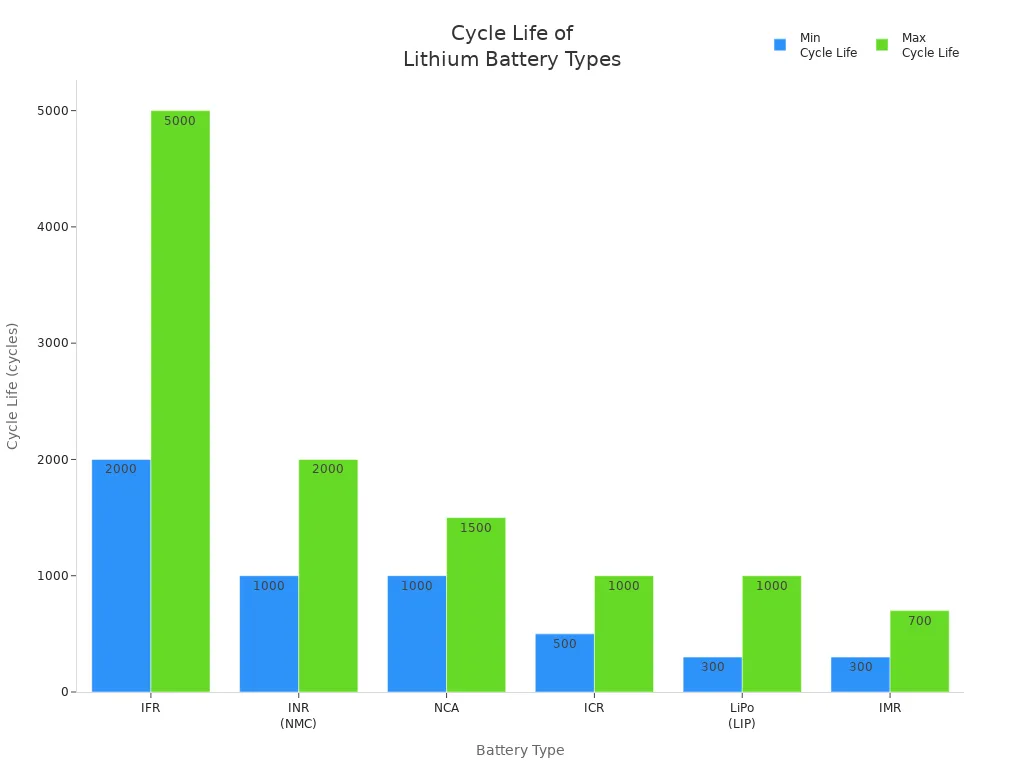
Note: A conservative estimate for lipo battery life is about 300 charge cycles. Some high-quality lithium-ion batteries may last longer, but many will need replacement after two to three years due to chemical aging.
Several factors affect the cycle life of a lipo battery:
- Avoiding deep discharges helps extend battery life. Keeping the charge above 20% reduces stress on the cell.
- High temperatures speed up chemical breakdown and shorten cycle life.
- Low temperatures lower battery efficiency and capacity.
- Proper thermal management and moderate depth of discharge can help a lithium-ion battery last longer.
| Faktor | Effect on Cycle Life and Performance |
|---|---|
| Depth of Discharge | Shallow Discharge (<25% DoD): Extends battery lifespan. Deep Discharge (~80% DoD): Reduces longevity but common in high-performance use. |
| Temperature Range | Optimal: -20°C to 60°C (ideal 20-25°C). High Temperatures: Accelerate degradation, increase thermal runaway risk. Low Temperatures: Reduce capacity and discharge efficiency. |
| Storage & Usage Tips | Avoid deep discharges. Store at 40-60% charge. Maintain recommended temperature range for longevity. |
Scientific studies show that both temperature and depth of discharge have a strong effect on cycle life. Higher temperatures and deeper discharges cause faster aging in lithium-ion cells. By controlling these factors, users can improve the performance and reliability of their lipo battery.
Spannungsstabilität
Voltage stability is a key performance characteristic for any lithium battery. The lipo battery provides a stable output voltage during most of its discharge cycle. Each cell starts at 4.2V when fully charged and drops to about 3.0V when empty. Most devices operate best when the cell voltage stays between 3.5V and 4.2V. Within this range, the lipo battery maintains a flache Entladekurve, which means the voltage does not drop quickly until the battery is nearly empty.
This stable voltage output helps electronic devices run smoothly. Devices like smartphones, tablets, and wearables rely on this steady voltage to avoid sudden shutdowns or performance drops. The lipo battery outperforms many other battery types in this area. For example, older nickel-based batteries show a more rapid voltage decline as they discharge.
Tip: The voltage stability of the lipo battery depends on factors such as load, temperature, battery age, and internal resistance. Regular monitoring and proper care help maintain stable voltage and extend battery life.
The reliable voltage output of the lipo battery supports sensitive electronics and helps prevent data loss or device errors. This performance characteristic makes the lipo battery a trusted choice for modern portable devices. The combination of stable voltage, high energy density, and flexible design gives the lipo battery an edge over other lithium-ion batteries and traditional battery types.
Applications in Portable Electronics
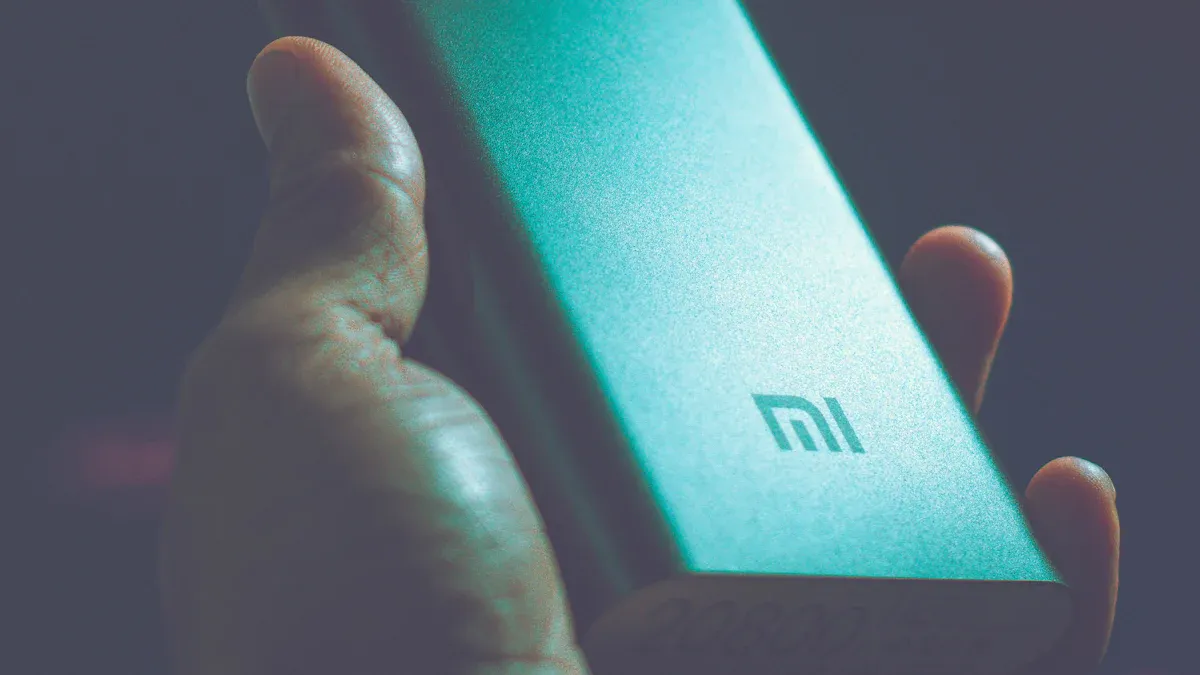
Smartphones and Tablets
Smartphones and tablets rely on the lipo battery for power because of its high energy density and slim design. These batteries store a lot of energy in a small space, which helps devices stay thin and light. The flat and lightweight shape fits well inside modern phones and tablets. The lipo battery also provides stable performance and safety features, such as built-in protection circuits. Users benefit from longer usage times and reliable power. The 3.7V voltage matches the needs of most mobile devices, supporting fast response and smooth operation.
- High energy density (500–620 Wh/L)
- Flat, lightweight, and customizable shapes
- Stable and reliable performance
- Built-in safety features
Wearables
Wearable devices, such as smartwatches and fitness trackers, use lipo battery technology because it is both light and compact. Most wearables need batteries with capacities between 100mAh and 500mAh. The lipo battery supports long-lasting power for continuous tracking and monitoring. Its small size makes it comfortable to wear all day. Manufacturers can customize the battery’s shape and size to fit different designs. The lipo battery also charges quickly and lasts for many cycles, which means users do not need to replace it often.
Note: The stable voltage output and high safety standards of the lipo battery make it ideal for wearables that require reliable and safe power.
Drones and RC Devices
Drones and remote-controlled (RC) devices use the lipo battery to achieve better performance and longer flight times. By connecting several 3.7V cells in series, these devices can increase voltage and power. Higher voltage packs help motors run faster and more efficiently. The lightweight design of the lipo battery reduces the total weight, allowing drones to fly longer and maneuver better. The battery’s high capacity and discharge rate support quick acceleration and stable power during flight.
Other Devices
Many other portable devices benefit from the lipo battery. Power banks, wireless chargersund solar-powered chargers use these batteries to deliver portable energy. Thin laptops require ultra-thin lipo battery cells to fit inside slim cases. Solar systems use lipo battery packs for reliable energy storage and long cycle life. The table below shows some common applications:
| Device Category | Beispiele |
|---|---|
| Power Banks | Mini, Slim, High Capacity, Laptop, Outdoor |
| Wireless Chargers | Magnetic, Alarm Clock Wireless Charger |
| Thin Laptops | Ultra-thin, Moldable Pouch Cells |
| Solar Systems | Home, Outdoor, Portable Solar Storage |
Design constraints, such as limited space and the need for lightweight components, shape the choice of battery in these devices. The lipo battery meets these demands by offering flexible shapes, high energy density, and strong safety features. These qualities make it a top choice for many portable electronics applications.
Safety of LiPo Battery
Built-in Protection
Manufacturers design every lipo battery with multiple layers of protection to meet strict safety requirements. These batteries use a protection circuit to monitor and control the flow of electricity. The circuit prevents overcharging, over-discharging, and short circuits. A typical 3.7V lipo battery includes a Protection IC or PCB. This board enforces current limits and keeps the battery chemistry stable.
- The protection circuit often limits current to about 8 amps.
- A 7-amp polyswitch helps stop damage from high current or wrong polarity.
- The PCB provides overcharge, overcurrent, and short circuit protection.
- The circuit monitors the cell and cuts off power if it detects unsafe conditions.
These safety mechanisms help prevent overheating and reduce the risk of thermal runaway. The protection circuit also extends the life of the battery by stopping dangerous situations before they cause damage. Most lipo battery packs used in robotics, RC toys, and portable electronics include these features as standard.
Built-in protection circuits use several methods to keep the battery safe:
| Schutzfunktion | Funktion |
|---|---|
| Schutz vor Überladung | Stops charging if voltage goes above safe limits |
| Schutz vor Überentladung | Cuts off power if voltage drops too low |
| Überstromschutz | Limits current to prevent overheating and damage |
| Kurzschlussschutz | Disconnects the battery if a short circuit occurs |
| Thermal Protection | Monitors temperature to avoid thermal runaway and cell damage |
These circuits work together to reduce battery failure rates. They limit high current surges, open electrical paths under pressure, and release gas safely if needed. Heat-related failures rarely occur because of these combined protections. However, the protection circuit cannot always stop failures from internal cell defects or thermal runaway once it starts. The effectiveness of these features depends on the quality of the approved safety circuit and the integrity of the battery’s design.
Note: While built-in protection greatly improves safety, users should never rely only on the circuit. Damage from static electricity or faulty chargers can disable safety features without warning.
User Best Practices
Users play a key role in maintaining the safety of a lipo battery. Following safety precautions helps prevent accidents and extends battery life. The following best practices help users avoid common risks:
- Always use a charger made for lipo batteries. Never use chargers for other battery types.
- Store batteries in cool, dry places between 40°F and 80°F. Avoid cars or direct sunlight.
- Never leave a battery unattended while charging. Watch the process closely.
- Prevent short circuits by keeping positive and negative leads apart. Cut wires one at a time.
- Charge batteries in fireproof containers and away from anything that can burn.
- Check batteries for swelling, damage, or deformities before charging. Do not charge damaged batteries.
- Avoid over-discharging below the minimum voltage. This prevents internal cell damage and fire risk.
- Store batteries at about 40-60% charge for long-term storage.
- Use balance charging with the correct connectors and settings for the battery’s cell count and voltage.
- Dispose of damaged or old batteries at recycling centers. Never throw them in the trash.
- Keep batteries away from children and pets.
- Let batteries cool to room temperature before charging.
- Charge each battery pack by itself. Only charge packs in series if voltages match exactly.
- Limit charging current to 1C or less to avoid damage and thermal risk.
Tip: Store lipo batteries in fireproof bags or metal containers with tight lids for extra safety.
A lipo battery should always be stored at a voltage between 3.7V and 3.85V per cell. This helps preserve battery health and prevents thermal issues. Users should avoid exposing batteries to temperatures above 170°F for long periods. When transporting, keep the temperature between 20°F and 150°F.
| Beste Praxis | Nutzen Sie |
|---|---|
| Richtiges Ladegerät verwenden | Prevents overcharging and circuit failure |
| Store at safe temperature | Reduces risk of thermal runaway |
| Monitor charging | Catches problems early |
| Inspect before use | Avoids using damaged cells |
| Proper disposal | Protects environment and meets safety laws |
By following these safety precautions, users help the protection circuit do its job. Good habits, combined with built-in safety features, make the lipo battery a reliable and safe choice for portable electronics.
Safety Concerns and Handling
Charging Risks
Charging a 3.7V LiPo battery brings several safety concerns that users must understand. Many incidents happen during charging because the cell can become unstable if handled incorrectly. The most common risks include fire hazards from overcharging, charging damaged or swollen cells, and short circuits caused by battery leads touching. Over-discharging below 3V per cell can also damage the cell and increase the risk of thermal runaway. Physical damage, such as swelling or puncture, raises the chance of fire or thermal runaway.
Charging in a fireproof container and using a charger designed for LiPo batteries helps reduce these risks.
A protection circuit inside the battery helps prevent overcharging and short circuits, but users should always inspect each cell before charging. Never charge a battery that shows swelling, leaks, or other damage. Charging in areas with high temperatures or near open flames increases the risk of thermal events. Users should avoid leaving batteries unattended during charging and always follow the manufacturer’s instructions.
Common charging safety incidents:
- Fire hazards from overcharging
- Charging damaged or swollen cells
- Short circuits from battery leads touching
- Over-discharging below 3V per cell
- Physical damage leading to swelling or puncture
- Charging in unsafe conditions, such as near heat sources
Storage and Disposal
Proper storage of 3.7V LiPo batteries protects both the battery and the environment. Safe storage keeps the cell stable and prevents thermal issues. Users should store batteries at a voltage between 3.7V and 3.85V per cell, which is about 40%-60% charge. This range helps prevent electrolyte decomposition and electrode damage. The best storage temperature is between 15°C and 25°C in a cool, dry place. Humidity should stay below 60%. Storing batteries in antistatic bags with desiccants prevents corrosion.
Tip: Store batteries in fireproof containers or LiPo safe bags away from flammable materials.
Physical protection is important. Insulate the electrodes and avoid shocks or pressure that could damage the cell. Every three months, check the battery voltage and recharge if it drops below 3.3V per cell. Good ventilation in storage areas prevents gas buildup from battery decomposition.
Recommended storage steps:
- Keep battery voltage between 3.7V and 3.85V per cell.
- Store in a cool, dry, and ventilated area.
- Use fireproof containers or explosion-proof bags.
- Protect from mechanical damage and shocks.
- Inspect and recharge if voltage drops.
Disposal of LiPo batteries requires care to avoid environmental harm. Recycling recovers valuable materials like lithium, cobalt, nickel, and copper. Manufacturer take-back programs and community collection events offer safe disposal options. Before disposal, tape the terminals to prevent short circuits, store in a cool, dry place, and label the battery for recycling centers.
Proper disposal methods:
- Use manufacturer take-back programs or local hazardous waste events.
- Tape terminals and label batteries before recycling.
- Never throw LiPo batteries in the trash to avoid chemical leaks.
Safe storage and disposal practices protect users, property, and the environment from the dangers of thermal runaway and chemical leaks.
Design and Future Trends
Innovations
Manufacturers continue to improve 3.7V LiPo batteries by focusing on safety, energy storage, and performance. They use new materials and smart designs to balance energy density, power output, and thermal management. Die PKNERGY 3.7V LiPo battery shows how companies achieve this balance. It uses lithium-ion polymer chemistry for high energy storage in a thin, light package. The battery supports a steady power output and works well across a wide temperature range. Built-in safety features, such as protection circuit modules, stop overcharging, over-discharging, and short circuits. A 10K NTC thermistor monitors temperature and prevents overheating. Many batteries now have CE certification, which means they meet strict safety and environmental rules.
Recent innovations include:
- Protection circuit modules for safer charging and longer battery life
- Temperature sensors for better thermal management
- Compact designs that fit more energy storage into smaller spaces
- Reliable voltage output for stable device performance
Manufacturers also design batteries to match the size and needs of each device. They use smart battery management systems to keep batteries safe and efficient.
Emerging Applications
The future of 3.7V LiPo batteries looks bright as new devices appear in the market. Many advanced portable electronics now use these batteries because of their flexible shapes, high energy storage, and lightweight design. Some new applications include:
- Advanced IoT devices for smart homes and cities
- Wearable health trackers, such as hydration monitors and smart bras
- AI-powered GPS communicators for children
- Desktop AI robots and portable gaming companions
- Wireless tattoo machines and smart rings with cameras
- Keychain cameras and smart chargers
Trends in portable power solutions show a move toward higher capacity, longer lifespan, and more features. The rise of 3S LiPo packs supports devices that need more power without adding much weight. People want quick charging, solar charging, and safe, eco-friendly batteries. As more people travel and work remotely, the demand for reliable energy storage grows. Manufacturers respond by making batteries that last longer, charge faster, and work safely in many conditions.
Tip: Smart battery management and eco-friendly designs will shape the next generation of portable electronics.
3.7V LiPo batteries power modern portable electronics because they offer:
- High energy density for longer use in small devices
- Lightweight, flexible, and customizable designs
- Reliable voltage and long cycle life
- Minimal memory effect for better performance
Proper handling remains vital. Users and manufacturers should:
- Avoid extreme temperatures and overcharging
- Use correct chargers and follow safety instructions
- Store and charge batteries in safe containers
The market for 3.7V LiPo batteries will keep growing as new devices need safer, lighter, and more powerful energy solutions. Choosing batteries with both strong performance and safety features ensures the best results.
FAQ
What makes a 3.7V LiPo battery different from other lithium batteries?
A 3.7V LiPo battery uses a flexible polymer electrolyte. This design allows for lighter weight and more shapes. Many other lithium batteries use a liquid electrolyte and a rigid case.
How long does a 3.7V LiPo battery usually last?
Most 3.7V LiPo batteries last between 300 and 1,000 charge cycles. Good care, such as avoiding deep discharges and high heat, helps the battery last longer.
Can users charge a 3.7V LiPo battery with any charger?
No. Users should only use chargers made for LiPo batteries. The wrong charger can cause overcharging, overheating, or even fire.
What should users do if a LiPo battery swells or leaks?
Users should stop using the battery right away. Place the battery in a fireproof container. Take it to a recycling center for safe disposal.
Are 3.7V LiPo batteries safe for children’s devices?
Manufacturers often use 3.7V LiPo batteries in toys and learning tools. Built-in safety circuits help protect users. Adults should always supervise charging and storage for extra safety.

